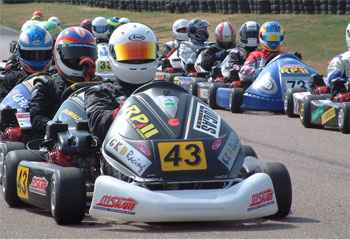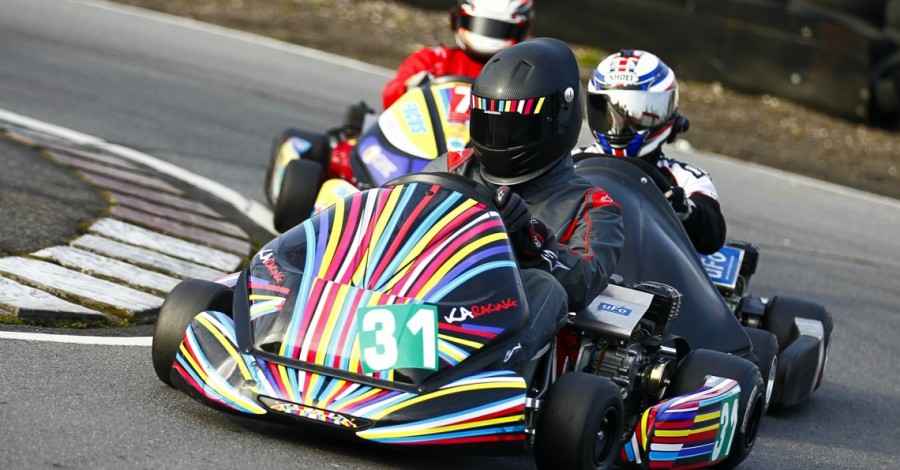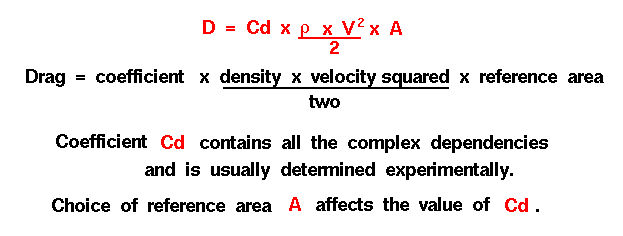I would think that the most drag on a kart would be the vacuum created behind the driver and seat?
When you can do something to decrease the frontal area, drag or both it can help.
So generally shorter people will sit lower in the kart. It can depend on the seat being used, amount of tilt and so on. It can help, but then when you look at the build of someone like Simas Juodvirsis who put on a stellar performance at the supernats in 2012… it’s hard to know for sure.
The point of the new bodywork is to reduce frontal area, and streamline flow over the largest obstruction, the driver. In karting, reducing the drag coefficient will save lap time, no debate about that, but the question is how much.
After racing bicycles for years, where you are the engine, and aero is the single largest energy saver, YES, AERO MATTERS, at all speeds, and grows exponentially with speed.
I mean, it could be worse.


Ardigo smoked them and I didn’t realize how fast they are really going in KZ over there. No doubt the nose and nassau help in KZ, in Europe. 206 and TaG in the US, probably not so much.
For what it’s worth, I’ve done a lot of aero stuff through the last year or so and making sure to do the best I can to make it pay off. I calculate aeropower in Racestudio since it weighs so heavily into a calculated dyno calculation. It’s also useful because if you see that all of the sudden your power output increases at a similar proportion to your supposed aeroHP increasing you can see that drag isn’t as big as you thought. It’s a great draft detector and cuts out some of the BS when looking at flyer laps espeically from mutliple drivers when I can’t remember every single straightaway pull of every single session.
Anyways, to put it into perspective for you just how big of an influence aero is, in a mini kart (not even a full size kart) with an average lap speed of 68.2 [km/h] and a minimum and maximum of 38.5[km/h] and 92 [km/h] has a lap average Aero power of 2.41 [hp] and a max of 5.27 [hp]. To put this in perspective since a lot of dyno results are skewed, 13.7 [hp] is considered max output with these calculations. This is the range I use for all of my simulation stuff and it seems pretty spot on. Granted some dynos will read higher than others, but instant output measures overall vehicle power and not engine output, so it takes rolling resistence and drag into account. To quantify that, on a sub-60 [mph] track in a mini kart, the drag averages around 17.5% of max output. That’s a lot. The theory that karts aren’t fast enough for aero just isn’t true from a drag perspective. We aren’t necessarily fast enough to produce effective downforce but that is an entire other can of worms with a lot of other factors.
I threw it through a quick lap simulation just for giggles - a 10% reduction in drag coefficient (a lot but not unheard-of) is worth around 3 tenths at Ocala in a mini (which is a relatively slow track with near-no straights) even before changing gear ratio and without considering that it can be accompanied with a change in frontal area. I’ll throw one in for New Castle if I get a chance later - I only have the Ocala model on my laptop and the rest are at home. Pretty insane - it’s clear why the people at OTK are pursuing it.
As Newey talked about in his book “How to Build a Car” (highly reccomend it, here’s a link: http://a.co/idiRzTg), he never wanted to focus on aero. It was just the only thing that made that big of a difference. Unless you’re able to build and develop your own tires and aren’t confined to a spec engine formula, the only thing that you have enough freedom to really find a massive technical advantage in is aero.
In before we see a new Tillet T1776t seat -> they might need to make a call to us over here across the pond to get the mold though… 
Canned correlation /=/ causation statement goes here ![]() There was (maybe?) a bunch of the hot dog bun nassaus buried in the field too and that’s the crux of what I’m getting at.
There was (maybe?) a bunch of the hot dog bun nassaus buried in the field too and that’s the crux of what I’m getting at.
Racing (well sport) is about psychology as much as anything else right? Driver sees other driver win and sees something obviously different, concludes it was a contributing factor.
Alternative fuel routing system, motor builder sticker, ceramic axle bearings, fancy anodised head on the motor etc etc. The challenge is separating the real determining factors and throwing away the rest.
Aero certainly makes a difference as @PosiMo_Andy put in great detail. While the average speeds of karts are (generally) low, the drag/power ratio is very high (Ok except laydowns).
CIK bodied karts have a large frontal area and massively poor CoD. So there are advantages to be gained, but there’s also dimension limits on the bodywork so any solutions have to work within those constraints.
Does this “hot dog bun” thing actually improve things, that is the question. I’m finding it hard to see it as probable.
Will it sell? No question there. People saw it on Ardigo’s kart and he won with it on there, so people will buy it.
One of the easiest aero things you can do and it doesnt cost a penny: Get your shoulders down and knees up. When I did some calcs a few years ago I found even an inch would reduce the frontal area by quite a bit.
Of course, getting down like that that presents comfort and chassis tuning challenges.
That’s what Dismore does on the straights at New Castle, as opposed to the front tuck everyone else does. I would imagine he would know what works best there.
Brilliant stuff @PosiMo_Andy, super interesting!
Clearly they need to do away with front tires. Those appear to make the most drag.
Well they sort of have, they’ve made the nose cone wide enough to cover the front tires and direct the air around that positive pressure area.
Drag itself is a fairly simple calculation;

And you can work out Cd relatively simply with a coast down test (assuming you have a nice clutch that fully disengages and your bearing have limited frictional drag).
Velocity can be pretty significantly effected by windspeed especially at our speeds so i don’t know how anyone does that without a pitot static tube. Just a 10mph head wind at 50mph increases drag by 30% and a 10mph tail wind decreases drag by 36%.
Yeah basically what I did was take the Cd and frontal area from one of the two papers I read above and plugged those into an online drag racing calc which I cannot find anymore (of course). It’s rough, but it did give me an idea of how much of an impact aero has.
There were only 2 drivers with the hot dog bun panels. One was Ardigo and the other was Puhakka who finished P3 after starting from P16.
In road racing, I’d even tuck my left foot under the nassau on the straights.
There was an episode of Jay Leno’s Garage a while back, in which he had a karter at Streets of Willow running some laps. The second run they removed the bodywork to see what the differences were. If I remember right, without the bodywork, the lap was slower mostly due to the ability to get front traction to turn the kart.
I guess you’d have to see the data to be sure exactly why it was slower. For sure, at somewhere like SOW, without a nosecone you’re going to have air under the chassis lifting it up.
The first batch of 250 superkart drivers learned about this the hard way back in the 70’s 
It’s interesting that you mention Dismore not tucking but dropping his shoulders. I have always had a bad back from playing hockey as a kid, so I could never comfortably tuck in the seat like others. I’m also a 6’2" guy, so I sit in the wind a bit higher than some others in the field. I always felt like I should definitely be trying to tuck behind the wheel/fairing down the straights, but never could.
I tried pushing myself as far back/down in the seat as I could down the straights after a while. I definitely felt like I could suck up to a driver in the draft better when I was leaning back vs. just staying in the seat as I normally am. I have no actual data from trying it, but I want to look at data from that both at Badger and New Castle if I get a chance this year.
Back to the original point - I was bored and killing time today so I rudimentarily modeled the hot dog fairing in solidworks and ran CFD on it - it’s only solidworks CFD and nothing crazy like Ansys and without holding one I’m sure I got near-all of the geometry wrong. That said, it’s enough to illustrate the concept.
I’m still learning CFD as well so I know it won’t be perfect, but it definitely does the intended job of kicking air over where the driver’s head would be if you look at the velocity vectors in a cut plot.
Now the other important thing is the frontal pressure - with a big upper fairing with the kick like M6 has, it’s obviously a source of a lot of pressure. OTK seemed to get around this by only kicking the air in the center and having the rest fall by the wayside.

Apart from the little bit at the front where it’s more vertical, there’s not a ton of excess pressure at the front.
Seems to me from these that OTK managed to still kick air over the head of the driver without having that massive frontal area sticking up being a source for pressure. Basically the good driver flow dynamics of M6 with the good frontal area and vehicle flow of the Parolin nose. I tried to get streamlines to render but my Surface doesn’t have enough oomph - I’ll have to plug it in on a stronger computer sometime soon.
Without having a full vehicle CFD - which I could do but didn’t want to spend a ton of time integrating it into a real model considering none of this was even measured and just guesstimated from the photoshop measuring tool and pictures and measuring relative distances. Still fun to see.
Cheers, if anyone can see more out of these results than what I saw, feel free to chime in. External CFD isn’t what I spend my life working on so there are probably some holes.
tl;dr I think it works.
Out of curiousity, are there rules surrounding the bodywork? Can you just go race with an entirely new design? Or does it have to be approved?